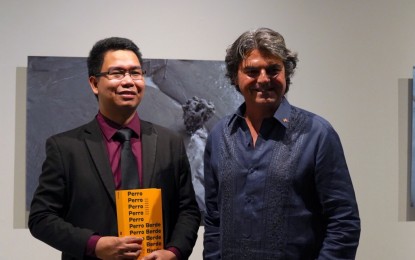
FILIPINO-SPANISH MAGAZINE LAUNCH. PCOO Global Media Affairs Chief JV Arcena holds a copy of Perro Berde, a Filipino-Spanish magazine. Beside Arcena is Spanish Ambassador to the Philippines Jorge Moragas. (Contributed photo)
MANILA -- The Spanish Embassy in Manila, in partnership with the Spanish Agency for International Development Cooperation and Instituto Cervantes de Manila, launched the eighth issue of the Filipino-Spanish cultural magazine, Perro Berde, on Thursday, March 28.
Perro Berde literally translates to “green dog” in Spanish, but figuratively means something out of the ordinary -- which represents ties between the Philippines and Spain, Spanish Ambassador to the Philippines Jorge Moragas said.
“Perro Berde in Spanish is an expression to describe something special, different and unique, so all the cultural work of what we've been doing in the Philippines last year is reflected in this very well designed, bilingual book and we celebrated that with the writers and the cultural people of the Philippines,” Moragas said in an interview with PCOO Global Media Affairs Chief JV Arcena, during the launch at the Bellas Artes Outpost in Makati City.
The bilingual issue, with its appealing new design and contents, aims to further promote Filipino-Spanish cultural relations. Since 2009, Perro Berde has provided a space for artists, writers, and researchers from both the Philippines and Spain.
Spanish Embassy First Secretary of Administrative and Cultural Affairs Pilar Cuadra Gascón, who also worked on the magazine’s editorial coordination, said the latest issue of Perro Berde is “one that goes beyond the paper" due to its interactive features.
“In this magazine, what we tried to do was to reflect on the [artistic] ties that linked the Spanish and the Filipino cultural scenes. In this double issue, we have included some QR codes where you can listen to music. There’s also a video and an audio guide from a group of very young Spanish artists where you can visit any museum, or any art gallery anywhere in the world,” she said.
“From a cultural point of view, I think we can promote the contact between the Spanish and Filipino artists and institutions. We just need to give them a little push in the right direction so eventually on their own, they will work more and more together,” Gascón added.
Meanwhile, the General Consul of Spain in Manila Fernando Heredia Noguer highlighted that Perro Berde goes beyond the strong bilateral relations between the Philippines and Spain.
“It’s an effort to promote Filipino culture regardless of bilateral ties, but it’s focused on really helping each other. We're doing this for the Philippines and for the Filipino young artists. This is for Filipinos and the Filipino culture,” he said.
“It’s cultural diplomacy at its best,” former Instituto Cervantes Manila Director Carlos Madrid Álvarez-Piñer pointed out.
In the eighth issue of Perro Berde, readers will get a glimpse of the works of Spanish multidisciplinary and award-winning artists such as Cristina Lucas with her series of photographs that show the world is without end, or “Sin Fin”; Fernando Sánchez Castillo with his sticker insert bearing a historical photograph on the longest labor strike in the Philippines that encourages people to stick them anywhere; and Nicolás Combarro’s photographs that highlight Manila’s “Architecture of Resistance” that represents structural logic mixed with cultural heritage while it defies economic, social, and political determinants.
Also featured in the issue is Ateneo Art Gallery (AAG) Director and Chief Curator Maria Victoria Herrera interviewing Catalan artist Domènec – whose work can currently be viewed at AAG – on his conceptual art practice and public space interventions; a collaboration between Equipo Sub-21, a group of young people aged 16 to 21 years old, and CA2M Centro de Arte Dos de Mayo in Madrid, that shows an unorthodox audio-visual museum guide; and Inteligencias Colectivas’ project that shows Intramuros’ contemporary and historic design presented through street food stalls.
Spanish band Belako and Filipino band Talahib People´s Music also contributed their entry about their song collaboration experience in the Posporos concert series in July 2018 where Spanish and Filipino bands performed.
Two winners from the Ateneo Art Awards also made their debut in Perro Berde. Alec Madelene Abarro, with her article “Duende, Yearning, and Mystery in Poetic Creation,” used Tagalog music that tackles the work of most distinguished Spanish poet Federico García Lorca; and Mary Jessel Duque, with a piece on telenovelas titled “Marimar: The Many Lives of the Woman by the Sea.” Spanish anthropologist Andrés Narros Lluch also published an excerpt of his soon-to-be-published book on the history of the island of Camiguin.
Readers can access the digital version of Perro Berde through its website www. perroberde. com. (PCOO Office of the Global Media Affairs)
(The Office of the Global Media Affairs is under the Presidential Communications Operations Office, tasked to connect Philippine government policymakers with the international media, and to promote priority policy messages through engagements with foreign audiences.)
